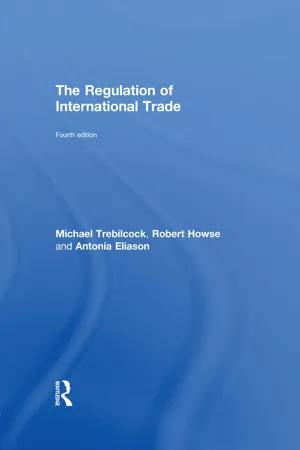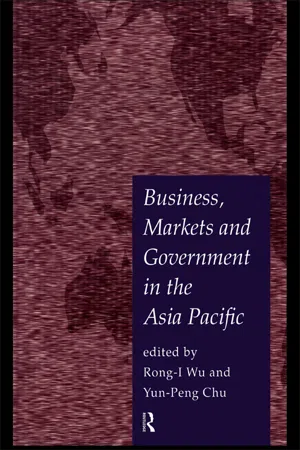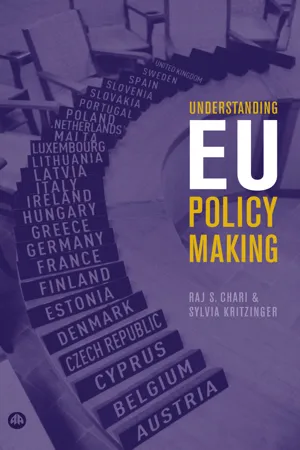Economics
Competition Policy
Competition policy refers to government measures aimed at promoting fair competition and preventing anti-competitive practices in markets. It encompasses regulations and laws designed to ensure that businesses operate in a competitive environment, fostering innovation, efficiency, and consumer welfare. The key objectives include preventing monopolies, regulating mergers and acquisitions, and addressing anti-competitive behavior.
Written by Perlego with AI-assistance
Related key terms
8 Key excerpts on "Competition Policy"
- eBook - ePub
- Peter Willis(Author)
- 2013(Publication Date)
- Informa Law from Routledge(Publisher)
In reality, markets do not conform to these theoretical constructs and this may provide a justification for governments to intervene. The breadth and nature of such state intervention when markets “fail” is the subject of extensive political debate and will not be canvassed here; suffice to say that competition law is part of this intervention. It is predicated on protecting an ideal of market interaction and is concerned that, when unconstrained by rivalry, businesses would seek to behave in ways that are considered socially undesirable.The four main elements of competition law and policy can be described in this way:— Prohibition of anti-competitive agreements: in the simplest form of such agreements, firms in a rivalrous position seek to dampen that rivalry by agreement on prices and/or output.— Prohibition of abuse of dominance: once a firm is sufficiently large that it is not hampered by rivalry from its competitors or from the behaviour of its customers, its self-interest will dictate that it behaves in a way that no longer benefits consumers, ie by seeking to exclude competitors or exploit customers.— Merger control: as an extension of concerns about agreements, the result of one company buying another firm may be the dampening of rivalry. To prevent market structures arising where firms do not compete effectively, Competition Policy can prohibit certain mergers and acquisitions.— Market investigations: these focus on the behaviour arising from the informal interaction of market participants, whereby structures or practices that hinder rivalry may have evolved without any specific abuse of dominance necessarily taking place.In this chapter we explore how economics is at the heart of these statutes. The rationale for their existence is the protection of means of delivering economic efficiency. The key aspect of analysis is the economic concept of rivalry; the main tools for conducting this scrutiny arise from economics.The chapter is structured as follows. Section 2.2 - eBook - ePub
The Regulation of International Trade
4th Edition
- Robert Howse, Antonia Eliason(Authors)
- 2013(Publication Date)
- Routledge(Publisher)
19 Trade and Competition Policy
THE BASIC ECONOMIC FUNCTION OF COMPETITION LAWS
In exploring the relationship between trade policy and Competition Policy, it is useful at the outset to review briefly the underlying economic theory on the welfare implications of monopoly, so that similarities and differences in the welfare frameworks that conventionally animate both trade policy and Competition Policy can be clearly kept in focus.1 The concept of ‘market power’ or ‘monopoly power’ – these terms will be used interchangeably – drives most aspects of modern competition laws. Whether one is concerned with a single-firm monopoly, competitors colluding with a view to acting as if they were a monopoly, a firm seeking to predate on existing or potential rivals in order to exclude them from the market, restrictive vertical distribution arrangements, or a merger that may lead to a dominant position, in every case the focus is on the social welfare implications of excessive market power. In economic terms, market power basically means the ability to increase prices profitably above (or reduce non-price dimensions of competition below) competitive levels by a nontrivial amount for an extended period of time. In order to establish whether any of the foregoing arrangements involve excessive market power, it is obviously necessary to define one or more relevant product and geographic markets in which the firms in question are alleged to be exercising market power, which largely turns on demand-side and supply-side substitution possibilities – an exercise that is central and problematic in most antitrust cases.2 - eBook - ePub
- Kjell A Eliassen, Nick Sitter(Authors)
- 2008(Publication Date)
- SAGE Publications Ltd(Publisher)
Since the early 1990s, and particularly as the European Union and its member states began to develop new and complex regulatory regimes for the newly privatised and liberalised utilities sectors, a third question has dominated much of the literature on theories of regulation: How has regulation developed? This literature approaches regulation and Competition Policy as a matter of long-term development. Although regulatory reform is driven by the quest for efficient rules of the game, it is almost always designed to operate in a broader institutional context, to fit an existing set of policies, institutions and rules of the game (Quirk 1988, Bulmer 1993, Majone 1996, Kassim and Menon 1996, Lodge 1999, Ogus 2002). Regulation is the product not only of political games, but also of the social, economic and legal contest in which it operates. The second and third parts of this chapter therefore turn to the comparative study of Competition Policy and regulation, and explore variation in regulation across countries and sectors as well as the present challenges of the regulatory state in Europe.The Comparative Study of Competition Policy and Regulation
The variation in capitalism found in Europe is also reflected in diversity in states’ approaches to regulation and competition. Whereas many EU members states have moved toward increasing use of strict and legally enforceable competition law and independent sector regulators, others have long preferred corporatism or mixed models. Yet all states face a common set of issues related the operation of competitive markets. The responses they adopt have varied, as has the extent to which anti-completive measures are interpreted as a problem, but a set of core questions are common the most Competition Policy regimes (Doern and Wilks 1996, Gerber 1998, Martin 1998).Regulating for competition
Competition Policy is essentially a ‘negative’ instrument in the sense that it lays down restrictions, in contrast to the ‘positive’ instruments such as subsidies and other government intervention in support of industry. Competition Policy is centred on law and legal action, and directed against (private) restrictions on competition. In contrast to a range of industrial policy instruments that might or might not be designed to promote competition, Competition Policy is essentially concerned with ensuring that the actors in the economy do not excessively restrict competition. This means that Competition Policy focuses on five central questions (though not all are addressed by all regimes).First, perhaps the oldest and most obvious challenge to free market competition is monopoly power. Although monopoly power is clearly advantageous to the firm that can use it to extract higher profits that would be possible under competition, it is problematic for the consumer that has to pay the higher price which constitutes the monopoly rent. Nevertheless, a number of states have chosen the grant monopoly rights or establish state-owned monopolies for a range of reasons. Some European telecommunications monopolies, for example, can be traced back to pre-industrial monopolies on postal communication that were designed to raise revenue. Others, such as the Nordic monopolies on the production, import and retail of alcohol, were instituted for heath reasons. In the case of utilities networks, the logic of ‘natural monopolies’ was usually taken to suggest that because it would be wasteful to run two parallel networks and a monopoly was therefore almost unavoidable, the monopoly should be state-owned so that the profits go to the state. - eBook - ePub
Evolution of Competition Laws and their Enforcement
A Political Economy Perspective
- Pradeep S Mehta(Author)
- 2012(Publication Date)
- Routledge(Publisher)
10 The evolution of competition law and policy in the UK * Andrew Scott Defined broadly, competition law has occupied a place in the corpus of English law for many centuries. While it elsewhere provided a foundation for the emergence of antitrust policy, however, the doctrine of the restraint of trade remained in Britain only a residual limitation on the freedom of commercial operators. Modern statutory Competition Policy first emerged in the aftermath of the Second World War, but even then the progenitors of such early emanations – no doubt mindful of the proven benefits of monopoly and cartelisation during times of crisis – were no free-market ideologues. In consequence, from today’s vantage the laws that they introduced were tentative, partial, and under-enforced. Indeed, it was only in 2000 with the coming into force of the Competition Act, 1998, and 2002 with the passage of the Enterprise Act, that the UK saw the completion of a rounded scheme of law. This scheme evinces the promotion of competition and economic efficiency, now the orthodox position in international terms, as its key underpinning rationale. 1 That the UK has only relatively recently introduced a coherent competition regime is a perplexing fact. Since the advent of the government of Prime Minister Margaret Thatcher in 1979, the UK has been a primary exponent of the neo-liberal philosophy that places faith in markets as the most efficient means of allocating societal resources. 2 Privatisation, liberalisation, deregulation, and the ‘contracting out’ of public competences all quickly became mainstays of British economic policy. Yet the introduction of the necessary corollary – an effective policy designed to police newly competitive markets – did not eventuate for almost two decades - eBook - ePub
- Joël-Thomas Ravix, Marc Deschamps(Authors)
- 2019(Publication Date)
- Wiley-ISTE(Publisher)
This explains why Competition Policy, this time acting as a market police, ensures that the State and all economic operators, both public and private, do not distort competition defined by the competitive order. However, while all are affected by the prohibition of anti-competitive practices (agreement and abuse of dominant position), States must also comply with certain rules relating to the subsidies they may decide to grant (section 1.2.2.1) and to public procurement law (section 1.2.2.2). 1.2.2.1. The framework for State subsidies It should be recalled that economic theory explains that, in perfectly competitive markets, any government subsidy is inefficient from a social welfare perspective. However, if the Pareto optimum cannot be achieved due, for example, to market failures (imperfect information, barriers to entry, market power, imperfect mobility of production factors, agglomeration effects, etc.), it becomes necessary to seek a second-best optimum (best solution after the Pareto optimum). However, in general, when one of the conditions for achieving the Pareto optimum is not met, it is not optimal for the other conditions to correspond to those that would have been achieved with the Pareto optimum. In other words, in a second-best optimum situation, subsidies can correct inefficiencies related to the imperfect nature of markets, as it is generally inefficient to want to remove all existing distortions. This is one of the foundations of the general principle that a State is never prohibited from providing subsidies to economic operators. Nevertheless, over the period 1980–2000, this general principle was the subject of a framework both at the level of international rules and at the level of European rules. At the international level, it is essentially the measures concerning subsidies under the GATT (General Agreement on Tariffs and Trade) and then the WTO (World Trade Organization) that are binding on European countries - eBook - ePub
Business, Markets and Government in the Asia-Pacific
Competition Policy, Convergence and Pluralism
- Yun-Peng Chu, Rong-I Wu(Authors)
- 2002(Publication Date)
- Routledge(Publisher)
5 The evolution of Competition Policy Lessons from comparative experience
Michael J. Trebilcock
This chapter has two central purposes: first, to reflect on what we have learned from one hundred years of domestic antitrust experience in selected Western industrialised economies; and, second, to explore some of the international dimensions of antitrust/Competition Policy in the light of globalisation of markets and consequent pressures for harmonisation of many domestic policies, including Competition Policy. The second section of this chapter sets out the basic economic function of competition laws in addressing the problem of monopoly or market power in its various manifestations. The third section provides brief overviews of the evolution of competition laws in the United States, Canada and the European Union. The fourth section identifies a number of important procedural and institutional issues in the design and administration of domestic competition law regimes that are highlighted by the comparative experience. The final section examines various international dimensions of domestic competition laws.THE BASIC ECONOMIC FUNCTION OF COMPETITION LAWS
It is useful at the outset to review briefly the underlying economic theory on the welfare implications of monopoly. The concept of ‘market power’ or ‘monopoly power’ — these terms will be used interchangeably — drives most aspects of modern competition laws. Whether one is concerned with a single firm monopoly, competitors colluding with a view to acting as if they were a monopoly, a firm seeking to predate on existing or potential rivals in order to exclude them from the market, or a merger that may lead to a dominant position, in every case the focus is on the social welfare implications of excessive market power. In economic terms, market power basically means the ability to increase prices above (or reduce non-price dimensions of competition below) competitive levels by a non-trivial amount for an extended period of time. In order to establish whether any of the foregoing arrangements involve excessive market power, it is obviously necessary to define one or more relevant product and geographic markets in which the firms in question are alleged to be exercising market power — an exercise that is central and problematic in most antitrust cases (see Landes and Posner 1991, p. 937). - eBook - ePub
- Raj S. Chari, Sylvia Kritzinger(Authors)
- 2006(Publication Date)
- Pluto Press(Publisher)
5 Competition Policy: ensuring a competitive European marketIn the first section of the chapter, we will consider the broad objectives of EU Competition Policy. While offering a brief analysis of the evolution of the overall policy area and aspects of its implementation process, we will examine whether or not the policy has the characteristics of being either a 1st order or 2nd order policy in terms of its impact and its evolution. The second section offers a more detailed analysis of a specific reform pursued in the policy area, focussing on the Merger Control Regulation of 1990. We will specifically consider which actors were involved in the initiation and negotiation process and, based on this analysis, how one should theoretically characterize these developments. The chapter argues first that EU Competition Policy can be considered a 1st order policy. The second main argument is that the major actors involved in the policy formulation process include both the Commission and representatives of capital, suggesting that both the supranational governance and the dominant economic class (DEC) perspectives are of value in explaining the policy.Objectives and evolution of Competition Policy and its “1st order status” in the integration processCompetition Policy seeks to ensure a level playing field for business in the single, integrated European market. This broadly means that member state governments should seek to improve economic competitiveness and that neither public nor private enterprises should be given a privileged market position vis-à-vis their competitors. As laid down in Article 3.g of the EC Treaty, regulations have been established in order to ensure that “competition in the internal market has not been distorted”. Such regulations are seen in four main areas: state aid, liberalization, anti-trust measures and merger control. This section considers the broad objectives and evolution of each in turn and then concludes that the policy has attained a 1st order status. The reader will note that the discussion of the objectives and evolution of the four areas is together comparatively larger than that of many other policy areas considered in this book. While this discussion reflects the complexity and depth of the subject, it also offers significant examples of developments in Competition Policy over the last decade. This will enable the reader to see the full dynamics acting in this policy area, which many observers of EU politics contend remains one of the most exciting. - eBook - ePub
Competition and Stability in Banking
The Role of Regulation and Competition Policy
- Xavier Vives(Author)
- 2016(Publication Date)
- Princeton University Press(Publisher)
Chapter 6
An Overview of Competition Policy Practice
IN THIS CHAPTER, WE REVIEW THE EVOLUTION of Competition Policy in banking, with special attention to the EU and the United States. We survey the concerns that competition authorities have shown recently with the banking sector, mostly in the EU and the UK, in section 6.1 ; and deal with four main areas of interest: market definition (section 6.2 ), mergers (section 6.3 ), cartels (section 6.4 ), and state aid (section 6.5 ). We also review recent developments in consumer protection policy (section 6.6 ), and we end the chapter with an overview of Competition Policy in banking in several emerging economies (section 6.7 ).1Before embarking into the revision, however, we introduce the chapter with a methodological remark and briefly survey the development of international practice.In chapters 4 and 5, we have considered the complexity of the competition analysis in banking due to the accumulation of market failures on top of market power (mainly asymmetric information and externalities), and because of its multiproduct and multimarket character. This leads to possible pitfalls when applying standard tools. There is no canonical model of competition in banking, and this translates into a lack of consensus on how to measure it. The theoretical and empirical debate on the relationship between concentration and stability is a good example of the state of the art. Important questions—such as what are the welfare implications of concentration and market power in banking or what are the effects on the financing of firms and the implications for financial stability—do not have a clear answer in the literature. The result is that the operational framework for Competition Policy in banking is based only partially on research and is not completely satisfactory. We have already stated the difficulties facing merger analysis in section 4.2.5 , and we illustrate in section 6.2
Learn about this page
Index pages curate the most relevant extracts from our library of academic textbooks. They’ve been created using an in-house natural language model (NLM), each adding context and meaning to key research topics.







